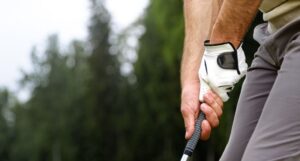Golf is a game that thrives in warm weather, but what happens when you step out on the course in cold weather? Many golfers wonder how playing in the cold affects their golf swing, their clubs, and even their golf ball. While the game might be more challenging in colder temperatures, it doesn’t mean you can’t enjoy winter golf. Understanding how cold weather impacts your golf game will help you adjust your strategy and equipment, ensuring you still play your best even when the temperature drops.
In this article, we’ll dive into how cold weather affects various aspects of your golf game, including your golf ball, clubs, and grip, and provide helpful tips to adapt to colder conditions. Whether you’re a seasoned player or a newcomer, this article is packed with practical advice to help you continue playing golf all year long.
How Cold Weather Affects Your Golf Swing
Golf is a sport that requires precision and consistency in your swing, but cold weather can make it more challenging. Cold temperatures can affect your flexibility and range of motion, which in turn influences the quality of your golf swing. When it’s cold, your muscles tend to tighten, making it harder to achieve a full swing.
Cold weather can also cause your body temperature to drop, which can make it difficult to maintain control of your golf swing. In colder weather, your golf swing may feel stiffer, and your body may not respond as fluidly as it would in warmer conditions. To overcome this, you should focus on warming up properly before hitting the course, using exercises that target flexibility and mobility. A well-executed warm-up will help loosen up your muscles, so you can execute a full swing even in cooler weather.
What Happens to Your Golf Clubs in Cold Weather
Cold weather doesn’t just affect your swing—it can also impact the performance of your golf clubs. When temperatures drop, both graphite and steel shafts can become stiffer. The flexibility of the shaft plays a key role in generating power during your swing, so the increased stiffness can cause a decrease in distance and accuracy. This is particularly true when temperatures dip below freezing, which makes your clubs less responsive.
Additionally, your golf grips tend to feel firmer in cold weather, which can affect your hold on the club. The reduced grip flexibility can lead to a less comfortable feel, potentially throwing off your focus during the swing. To minimize these effects, make sure to keep your clubs inside when not in use and invest in moisture-wicking gloves to improve your grip in cold conditions.
How Cold Weather Affects Your Golf Ball Flight
Perhaps the most significant impact of playing in cold weather is how the golf ball behaves in cold air. The colder temperatures make the air denser, causing the ball to travel shorter distances. Cold weather reduces the compression of the golf ball, which means it won’t fly as far as it would in warmer temperatures. Additionally, cold weather makes the ball harder, decreasing its ability to compress at impact, which in turn leads to shorter carry distances.
During winter golf, it’s important to adjust your expectations regarding distance. You might need to club up to compensate for the reduction in ball flight. Also, be aware that the golf ball will not spin the same way it does in warmer weather, which can affect your ability to shape shots or control approach shots around the greens.
Why Playing in Cold Weather Can Feel Different
When you play golf in cold weather, many factors can make the experience feel different from what you’re used to in warmer conditions. The air temperature and wind chill can make it harder to stay comfortable, and the mental game of playing in cold weather can also be challenging. Cold air makes it harder to keep warm, and prolonged exposure to low temperatures can impact your focus and concentration.
Additionally, your body temperature will play a role in how well you perform. If your body isn’t properly heated, your movements may become slower, which affects your golf swing mechanics. It’s important to layer your clothing and stay warm to ensure you remain focused and ready to play your best.
How to Protect Your Golf Equipment in Freezing Conditions
Cold weather can take a toll on your golf equipment if not properly cared for. For starters, avoid leaving your clubs in the car overnight during colder temperatures, as the freezing conditions can cause the grips to deteriorate or the shaft to become stiff. It’s best to keep your clubs in a heated environment or bring them inside after each round.
In addition to protecting your clubs, pay attention to your golf ball. The ball will feel harder in cold weather, which can affect how it reacts on the greens. Make sure to keep your golf ball warm before you tee off by storing it in your pocket or a thermal pouch. This will help maintain its optimal performance and give you better results on the course.
Tips for Adjusting Your Golf Game to Cold Weather
Adapting your golf game to cold weather requires both mental and physical adjustments. First, remember to dress in layers so that you can regulate your body temperature as needed. A hand warmer can help keep your hands warm, which is crucial for maintaining grip on the club and making solid contact with the ball.
Adjusting your golf swing for the cold is also key. Since your body may feel stiffer in cold temperatures, focus on making smooth, controlled swings rather than trying to generate power. A smoother swing will help you make consistent contact with the golf ball, even in colder weather. Moreover, consider clubbing up to account for the reduced distance in cold weather conditions.
Impact of Cold Air on Your Golf Grip
In cold weather, the golf grip can become more difficult to hold, which directly impacts your performance. The cold air causes your hands to lose some of their natural flexibility and warmth, which can make gripping the club feel stiffer. A firm grip can lead to tension in your hands and forearms, disrupting the flow of your golf swing.
To address this, try wearing gloves made from materials that retain warmth while also providing a good grip. Also, consider using golf grips designed specifically for cold weather. These grips are often made from materials that remain tacky and comfortable even in freezing temperatures.
How to Keep Warm and Maintain Focus While Playing in Cold Weather
Maintaining focus while playing in cold weather can be difficult, as both the physical discomfort and mental challenges of winter golf take their toll. One of the most important things you can do is stay warm, as being too cold can negatively affect your performance. Make sure to dress in moisture-wicking layers that help regulate your body temperature and provide insulation without adding bulk.
Mentally, it’s important to remain focused and not let the cold affect your concentration. Stay positive, keep your routine consistent, and remember that cold weather is just another challenge that can be overcome with proper preparation.
Does Cold Weather Affect Your Golf Course Strategy?
Cold weather does impact your golf course strategy. Because the golf ball doesn’t travel as far in cold weather, it’s essential to adjust your club selection, especially for longer shots. Consider hitting a club with a bit more loft to ensure you get the distance needed to reach greens or fairways.
Moreover, cold weather can affect your putting game. The greens may play firmer and faster due to lower temperatures, so be sure to adjust your putting stroke accordingly. The ball might not bite as much on the greens, so aim for more consistent, less aggressive putts.
Best Golf Gear for Cold-Weather Play
To make your cold-weather golf experience as comfortable as possible, you need the right gear. Aside from wearing layers and using hand warmers, investing in winter-specific golf gloves and winterized golf shoes can help you maintain control and comfort. Additionally, thermal golf bags and headcovers can help keep your equipment warm and protected from the cold.
Lastly, consider using a golf umbrella to shield yourself from rain or snow while you play. The right gear will ensure that you can continue enjoying golf in colder temperatures without sacrificing performance.
Conclusion
While cold weather might not be ideal for everyone, it doesn’t mean you have to give up on your golf game during the winter months. By understanding how cold weather affects your golf swing, equipment, and ball flight, you can adapt and continue playing your best. From adjusting your swing mechanics to properly caring for your golf equipment, these tips will help you navigate winter golf conditions with confidence.






























































